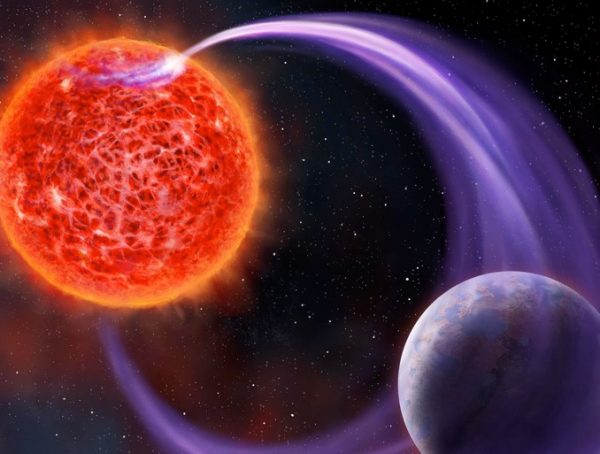Tell-tale signatures of aurorae new tool in hunt for exoplanets – Astronomy Now Online

The Dutch-led Low Frequency Array – LOFAR – radio telescope has detected low-frequency radio waves emitted by a nearby red dwarf that likely were generated by the interaction of the star’s magnetic field with the atmosphere of an unseen exoplanet, producing a detectable aurora. Such radio emissions are seen with Jupiter and its volcanic moon Io, and astronomers have predicted similar scaled-up star-planet interactions for more than 30 years. But LOFAR’s observations of the red dwarf GJ1151 are the first to show the phenomenon in deep space.
“The motion of the planet through a red dwarf’s strong magnetic field acts like an electric engine much in the same way a bicycle dynamo works,” said Harish Vedantham, lead author of a study in Nature Astronomy and a staff scientist at the Netherlands Institute for Radio Astronomy (ASTRON). “This generates a huge current that powers aurorae and radio emission on the star.”
The Sun has a relatively weak magnetic field and the solar system’s major planets are far enough away that such currents are not generated.
But that’s not the case for Jupiter and Io. Material ejected from Io’s numerous volcanos gives the small moon an atmosphere that includes electrically charged particles thanks to interactions with radiation. As the moon moves through Jupiter’s powerful magnetic field, currents are generated, pushing electrons along magnetic field lines toward the giant planet and emitting radio waves as they spiral inward.
Close to the planet, the magnetic field lines are bunched together, electrons begin interacting with each other and powerful radio beams are emitted.
“We adapted the knowledge from decades of radio observations of Jupiter to the case of this star,” said Joe Callingham, ASTRON postdoctoral fellow and co-author of the study. “A scaled up version of Jupiter-Io has long been predicted to exist in the form of a star-planet system, and the emission we observed fits the theory very well.”
Red dwarf stars are the most abundant in the Milky Way, and most are thought to host terrestrial plants “so there must be other stars showing similar emission,” Callingham said. “We want to know how this impacts our search for another Earth around another star.”
The habitable zones around smaller red dwarf stars are closer in than the zone Earth orbits in around the Sun. Because red dwarfs have stronger magnetic fields, planets in their habitable zones would be exposed to more intense radiation and other effects that could impact habitability.
The ASTRON researchers are now using LOFAR to look for more examples of similar star-planet interactions.
“The long-term aim is to determine what impact the star’s magnetic activity has on an exoplanet’s habitability, and radio emissions are a big piece of that puzzle,” said Vedantham. “Our work has shown that this is viable with the new generation of radio telescopes, and put us on an exciting path.”






